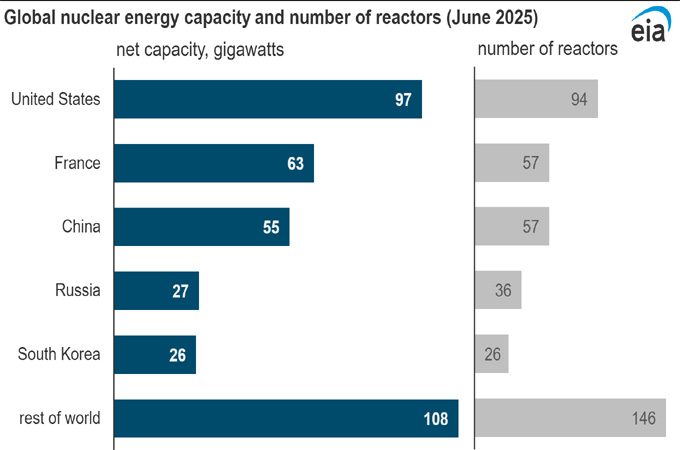Five countries account for more than two-thirds of the world’s total nuclear electricity generation capacity. The US has the most capacity, followed by France, China, Russia, and South Korea, based on International Atomic Energy Agency (IAEA) data as of June 2025.
Globally, 416 nuclear power reactors are operating in 31 countries, with a total installed net generating capacity of 376 gigawatts (GW), reported US Energy Information Administration (EIA).
The development of nuclear power plants for commercial electricity generation began in the US in the late 1950s with the commissioning of the Shippingport Atomic Power Station in Pennsylvania.
Most of the operating US nuclear generating capacity was constructed between 1967 and 1990.
Electric utilities in the US currently operate 94 nuclear reactors, and the country is the world's largest producer of nuclear electricity.
Domestically, nuclear electricity accounted for 782 gigawatthours (GWh), or 19 per cent of US electricity generation, in 2024.
US nuclear electricity accounted for 30 per cent of the global total in 2023.
The US nuclear reactor fleet operates at a comparatively high capacity factor (92 per cent in 2024) because of increased utility efficiency in managing planned and unplanned generation outages.
France maintains the second-largest nuclear reactor fleet in the world and the largest nuclear reactor fleet in Europe with 57 reactors with a total installed generating capacity of 63GW.
Nuclear reactors in France generated over 320GWh of electricity in 2023, which was nearly 65 per cent of the country’s total electricity generation.
Following the global oil crisis of the early 1970s, developers built 52 nuclear reactors in France between 1975 and 1990 in order to strengthen its energy security.
China has the fastest nuclear growth rate in the world with 57 reactors commissioned since 1991.
Another 28 reactors with a combined capacity of 30 GW are currently under construction, according to IAEA data.
Once completed, China’s total installed nuclear capacity would surpass that of France. China’s operating reactors produced over 433GWh in 2023, or 5 per cent of China’s total electricity generation.
China has acquired nuclear electricity technology from other countries such as France, Canada, and Russia.
Recently, China adapted the US company Westinghouse’s AP1000 reactor design into its CAP1000 design.
Russia operates 36 nuclear reactors with a total installed generating capacity of 27GW; another 4 units totaling 4GW are under construction.
Rosatom, Russia’s state-owned nuclear energy corporation, is updating the country’s reactor fleet from the smaller, light-water graphite-cooled RBMK units to the larger and more efficient light-water only VVER-1000 and VVER-1200.
Russia is currently the world’s largest vendor of nuclear generating technology.
South Korea’s energy policy is driven by energy security considerations and the desire to minimise dependence on imported fossil fuels.
South Korea started developing its nuclear power program in the 1970s and currently operates 26 reactors with another 2 reactors under construction.
South Korea’s state-backed Korea Hydro & Nuclear Power is an international nuclear vendor; it built the UAE Barakah power plant and will be the vendor for the Dukovany power plant expansion in the Czech Republic. -OGN / TradeArabia News Service































